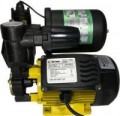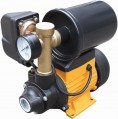Suction type
The main division in this parameter is related to whether the pump can remove air from the suction line. This, in turn, determines the features of starting the unit.
— Self-priming. Self-priming pumps include all pumps that do not require the complete absence of air in the suction line at startup — it is enough that the pump itself is filled with water. Accordingly, such models are less demanding and normally tolerate air entering the line. However, this requires a reliable design that can normally withstand water hammer, which accordingly affects the cost of the unit.
— Priming. Pumps with this device can only work normally when both the unit body and the suction line are filled with water. If air enters the line, it must be removed or the pump will not be able to start normally. Such models are not as convenient as self-priming ones; at the same time, they are noticeably cheaper, and with the normal quality of the water supply system, there is practically no significant difference between the two varieties.
Maximum particle size
The largest particle size that the pump can handle without problems. This size is the main indicator that determines the purpose of the device (see above); and in general, the larger it is, the more reliable the device, the lower the risk of damage if a foreign object enters the suction line. If the risk of the appearance of too large mechanical impurities is still high, additional protection can be provided with filters or grids at the inlet. However, such a measure should be considered only as a last resort, because from constant exposure to solid particles, the grids become clogged and deformed, which can lead to both clogging of the line and filter breakthrough.
Maximum liquid temperature
The highest temperature of water at which the pump is capable of operating normally. Usually, in most models this parameter is 35-40 °C — at high temperatures it is difficult to ensure effective cooling of the engine and moving parts, and in fact, such conditions are rare.
Engine type
Type of motor installed in the electric pump (see "Power source").
— Asynchronous. The most common type of electric motor nowadays. Asynchronous motors are simple in design and inexpensive, while they are very reliable. Their main disadvantage is the difficulty in regulating the rotational speed and the dependence of this frequency on the load on the rotor; on the other hand, in most cases, these shortcomings are not critical.
— Synchronous. Without going into technical details, we can say that this type of electric motor is considered more advanced than asynchronous — in particular, due to the ability to adjust the speed easily. At the same time, such units are difficult to manufacture and expensive, so they are rare — mainly in high-end technology, where adjustment accuracy is a key parameter.
Impeller / auger material
The material from which the main working element of the pump is made is an impeller, an auger or a membrane. This part is in direct contact with the pumped liquid, so its specs are key to the overall performance and capabilities of the pump.
— Plastic. Plastic is low-cost, and it is not subject to corrosion. It is believed that the mechanical strength of this material is generally low, and it does not tolerate contact with solid impurities. However, today there are many varieties of plastic — including special high-strength varieties that are suitable even for working with heavily polluted water or sewage. So plastic impellers/augers can be found in a variety of types of pumps; the overall quality and reliability of such parts, usually, depend on the price category of the unit.
— Cast iron. Solid, durable, reliable and, at the same time, relatively inexpensive material. In terms of corrosion resistance, cast iron is theoretically inferior to more advanced alloys like stainless steel or aluminium; however, subject to the operating rules, this point is not critical, and the service life of cast iron parts is no less than the total service life of the pump. The unequivocal disadvantages of this option include a large mass, which slightly increases the energy/fuel consumption during operation.
— Stainless steel. By the name, one of the key advantages of stainless steel is high resistance to corrosion — and, accordingly, reliability and durabili...ty. Such an alloy is somewhat more expensive than cast iron, but it also weighs less.
— Aluminium. Aluminium alloys combine strength, reliability, corrosion resistance and low weight. However, such materials are quite expensive — more expensive than the same stainless steel, not to mention cast iron.
— Brass. The varieties of brass used in pumps are distinguished by high strength and hardness, as well as insensitivity to moisture. Such materials are quite expensive, but this price is fully justified by the mentioned advantages. Therefore, in certain types of pumps — in particular, surface models and pressure tank units — brass impellers are very popular.
— Bronze. A material similar in many properties to the brass described above. However, bronze is used much less frequently — in particular, due to a slightly higher cost.
— Steel. Varieties of steel that are not related to stainless steel are used extremely rarely — in certain models of pumps for chemical liquids. At the same time, steel is usually used as a base in such parts, and a coating of fluoroplastic or other similar material is applied to it to protect it from corrosion.
— Silumin. Silumins are called aluminium alloys with the addition of silicon. For several reasons, such materials are rare in pumps, and mainly among relatively inexpensive models.
— Rubber. Material traditionally used for diaphragms in vibratory pumps (see “Pump type”).

